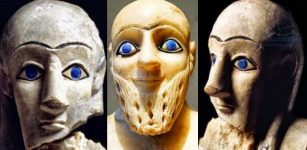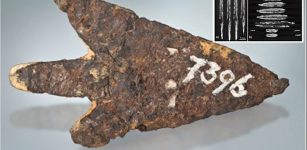Legend Of Marguerite de Bressieux: Brave Noblewoman Who Sought Revenge For Sexual Assault
A. Sutherland - AncientPages.com - They say it is only a legend, nothing more. You can believe it or not. Still, it could be a true story that could happen in any location at any time.
Ruins of Anjou Castle. The castle has a long history. With this castle is associated the memory of the Edict of Roussillon (August 8, 1564) by which Charles IX and Catherine de Medici imposed the date of January 1 as the first day of the year for the entire kingdom of France. Sold shortly after the Revolution, the castle of Anjou was largely destroyed between 1806 and 1813. Credit: Raydou - CC BY-SA 4.0
According to Humbert de Terrebasse (1842-1927), a lawyer and historian, this event took place during the Hundred Years' War (1337 - 1453), a struggle between England and France over a series of disputes, including the question of the legitimate succession to the French crown.
Ruins of Anjou Castle. The castle has a long history. With this castle is associated the memory of the Edict of Roussillon (August 8, 1564), by which Charles IX and Catherine de Medici imposed the date of January 1 as the first day of the year for the entire kingdom of France. Sold shortly after the Revolution, the castle of Anjou was largely destroyed between 1806 and 1813. Credit: Raydou - CC BY-SA 4.0
Marguerite de Bressieux was a French noblewoman born in Anjou, France, and lived in a castle with her parents.
The legend says that the castle was besieged and pillaged by rebel troops attempting to topple King Charles VII on behalf of a Burgundian nobleman, Louis de Chalon, the Prince of Orange.
Marguerite's father and mother were killed. The soldiers of Chalon raped her, her ladies-in-waiting, and other noblewomen. Marguerite buried the parents and then swore bloody revenge on Chalon and his ruthless men, whose shameless act proved to be the last they had committed.
However, they were not yet aware of what awaited them. Soon after the tragic incident, Marguerite and her ladies-in-waiting armed themselves and started military training that included riding in battle and sword fighting. Deeply motivated and ready to fight, they had only waited for the chance to encounter Chalon and his men in a competition.
Luckily, the women did not have to wait long. Finally, the king was ready to retaliate against Louis. When Marguerite heard that royal troops led by Raoul de Gaucort, governor of the Dauphiné, were being assembled to march against Chalon's soldiers, she made necessary preparations for the departure of her small group of female warriors in disguise.
Clad in black with faces covered with black scarves and with a pike or lance in one hand, they mounted their horses. One held a black banner decorated with heads superimposed over bones and silver tears. In the middle of these funeral emblems, there was an orange pierced by a spear, under which an inscription was visible: "Ainsi tu seras" ("Thus shall you be").
The orange was associated with Louis Chalon, the Prince of Orange.
Led by Marguerite de Bressieux, these brave women were perfectly aware of war risks and would not be denied their revenge.
At first, Gaucourt hesitated to allow Marguerite and her companions into his army but listened carefully to what the women had to say.
"Deign, noble lord, to accord us a place in your ranks. If our arms are weak, our hearts are strong and bent upon nothing but vengeance. Victims of the most cowardly, the most degrading outrage, we aspire to wash it out in blood." 1
Gaucort respected the determination of Marguerite and her companions and let them join the troops of King Charles VII on their way to encounter Chalon, Prince of Orange, and his men. Now a confrontation was imminent, and when it took place, Chalon's soldiers were surprised and could not believe their eyes.
They took the female warriors for frightening ghosts, who emerged from hell to take revenge on the living, but the women were real.
The black horse riders in disguise raised their visors before Chalon and his team. They bravely looked into the eyes of each of their rapists, who fled, terrified of fighting ghosts. They were chased by the royal troops who massacred them mercilessly, pushing the last of them into the Rhône River.
The legend further tells that Marguerite was deadly wounded in battle and had to wait for help for too long. Finally, her companions took her to a nearby convent, but she died several hours later.
She was buried with military funeral honors, and her companions decided to stay in the convent for the rest of their lives.
According to the legend, it happened in 1450 in France during the Hundred Years' War (1337-1453).
Updated on December 27, 2023
Written by – A. Sutherland - AncientPages.com Senior Staff Writer
Copyright © AncientPages.com All rights reserved. This material may not be published, broadcast, rewritten or redistributed in whole or part without the express written permission of AncientPages.com
Expand for referencesReferences:
- Schmermund E. Women Warriors
More From Ancient Pages
-
 Ancient Chinese Ingenuity Created Sophisticated Time Keeping Machines: Proof Of Remarkable Ancient Knowledge
Ancient Technology | Jan 14, 2019
Ancient Chinese Ingenuity Created Sophisticated Time Keeping Machines: Proof Of Remarkable Ancient Knowledge
Ancient Technology | Jan 14, 2019 -
 Mysterious Sumerian Statues With Big Blue Eyes – A Sign From The Gods
Civilizations | Feb 23, 2017
Mysterious Sumerian Statues With Big Blue Eyes – A Sign From The Gods
Civilizations | Feb 23, 2017 -
 First People To Inhabit Malta Arrived 700 Years Earlier Than Previously Thought
Archaeology | Mar 20, 2018
First People To Inhabit Malta Arrived 700 Years Earlier Than Previously Thought
Archaeology | Mar 20, 2018 -
 Yokai (Yōkai): Mysterious Interdimensional Force With Odd Abilities In Japanese Mythology
Featured Stories | May 15, 2017
Yokai (Yōkai): Mysterious Interdimensional Force With Odd Abilities In Japanese Mythology
Featured Stories | May 15, 2017 -
 What Were Victorian Bathing Machines?
Ancient History Facts | Jun 9, 2018
What Were Victorian Bathing Machines?
Ancient History Facts | Jun 9, 2018 -
 Bacho Kiro Cave: Genomes Of The Earliest Europeans – Sequenced
Archaeology | Apr 8, 2021
Bacho Kiro Cave: Genomes Of The Earliest Europeans – Sequenced
Archaeology | Apr 8, 2021 -
 Rare Discovery Of More Than 18,000 Inscribed Pot Sherds Document Life In Ancient Egypt
Archaeology | Jan 31, 2022
Rare Discovery Of More Than 18,000 Inscribed Pot Sherds Document Life In Ancient Egypt
Archaeology | Jan 31, 2022 -
 Arrowhead Made Of Meteoritic Iron From The Late Bronze Age Settlement Of Mörigen, Switzerland – Examined
Archaeology | Aug 1, 2023
Arrowhead Made Of Meteoritic Iron From The Late Bronze Age Settlement Of Mörigen, Switzerland – Examined
Archaeology | Aug 1, 2023 -
 LIDAR Technology Reveals Secrets Of Ancient Maya Civilization
Archaeology | Feb 3, 2018
LIDAR Technology Reveals Secrets Of Ancient Maya Civilization
Archaeology | Feb 3, 2018 -
 Ice Age Mystery – Unexplained Disappearance Of North America’s Large Mammals – New Clues
Fossils | Jun 1, 2024
Ice Age Mystery – Unexplained Disappearance Of North America’s Large Mammals – New Clues
Fossils | Jun 1, 2024 -
 Modern Humans Traveled Across The Eurasian Steppe 45,000 Years Ago
Archaeology | Aug 20, 2019
Modern Humans Traveled Across The Eurasian Steppe 45,000 Years Ago
Archaeology | Aug 20, 2019 -
 First Pompeiian Human Genome Sequenced Fron An Individual Who Died After The Eruption Of Mount Vesuvius In 79 C.E
Archaeology | May 26, 2022
First Pompeiian Human Genome Sequenced Fron An Individual Who Died After The Eruption Of Mount Vesuvius In 79 C.E
Archaeology | May 26, 2022 -
 Was The Discovery Of Biblical Abel’s Giant Grave In Syria Covered-Up?
Ancient Mysteries | Oct 28, 2014
Was The Discovery Of Biblical Abel’s Giant Grave In Syria Covered-Up?
Ancient Mysteries | Oct 28, 2014 -
 Abundant Hominin Fossils Dating Back 300,000 Years Excavated In Hualongdong (HLD), East China
Evolution | Aug 7, 2023
Abundant Hominin Fossils Dating Back 300,000 Years Excavated In Hualongdong (HLD), East China
Evolution | Aug 7, 2023 -
 The First Conservationists May Have Been Early Pacific Islanders Who Started The Practice 3,000 Years Ago
Archaeology | Sep 29, 2021
The First Conservationists May Have Been Early Pacific Islanders Who Started The Practice 3,000 Years Ago
Archaeology | Sep 29, 2021 -
 Is An Ancient Temple Dedicated To The Lioness Goddess Repit Hidden In The Cliffs Of Athribis?
Archaeology | Dec 10, 2024
Is An Ancient Temple Dedicated To The Lioness Goddess Repit Hidden In The Cliffs Of Athribis?
Archaeology | Dec 10, 2024 -
 On This Day In History: Battle of Englefield Was Fought – On Dec 31, 870
News | Dec 31, 2016
On This Day In History: Battle of Englefield Was Fought – On Dec 31, 870
News | Dec 31, 2016 -
 Vikings’ Unicorn Bluff Fooled Europeans For Hundreds Of Years
Ancient History Facts | Apr 24, 2018
Vikings’ Unicorn Bluff Fooled Europeans For Hundreds Of Years
Ancient History Facts | Apr 24, 2018 -
 Fascinating Artificial Caves Of Ventanillas de Otuzco And Its Secret Passageways – Pre-Inca Necropolis Of The Cajamarca Culture
Featured Stories | Feb 5, 2022
Fascinating Artificial Caves Of Ventanillas de Otuzco And Its Secret Passageways – Pre-Inca Necropolis Of The Cajamarca Culture
Featured Stories | Feb 5, 2022 -
 Llangernyw Yew: Chilling Prophecy Of The Oldest Tree In Wales
Featured Stories | Oct 28, 2022
Llangernyw Yew: Chilling Prophecy Of The Oldest Tree In Wales
Featured Stories | Oct 28, 2022


